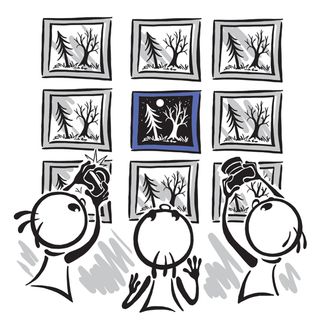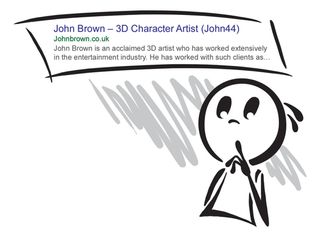7 self-promotion tips for 3D artists
Serhii Antropov, a PR at Humster3D, explains how to harness the web to boost your standing as a 3D artist.

It's time to talk about a relevant but rarely discussed theme in the 3D community: self-promotion. Or more bluntly speaking, how to win awards and get featured in magazines.
Creating a 3D masterpiece is just the beginning. The web is a huge place, and even the best work often goes unnoticed. So you need to actively try to get noticed by other artists and encourage people find your work.
01. Share your email address
The biggest problem for magazine and website editors who want to write about you or arrange an interview is often not knowing how to contact you. So any ambitious 3D artist needs to get an email address and be prepared to share it.
02. Create a website
Then next step is to create a personal website or blog and feature your e-mail address on it prominently.
You also need to help people find your site via Google. So make sure you add your name, surname, forum nickname and anything else people might use to find you prominently on the homepage.
What else should you include? Your work, in high resolution, along with any making-ofs or showreels if you have them. If you've carried out work for a client and/or as part of your job, make sure you get their permission first before including it.
Links to any interviews with you or articles you've had published should also be included, as well as any awards and prizes you've won for your work. This can be useful for galleries and websites that want to write about you. If they can't find any information they're more likely to write less about you, or not at all.
Get the Creative Bloq Newsletter
Daily design news, reviews, how-tos and more, as picked by the editors.
03. Join LinkedIn
Also create a page on LinkedIn and link to it via your website. This should contain the same 'About me' information as on your website, but in the more structured way that LinkedIn demands (and editors usually prefer).
04. Get your work into galleries
Once you've created your website, it's time to move on to the next step: publishing your work in online galleries.
There are many. Some accept work only with pre-moderation, some admit anything they're sent. Every CG forum has its own gallery, in one form or another, including 3Dtotal, CgArena, ArtStation and DeviantArt.
Well known communities such as BlenderArtists and ZbrushCentral also have their own galleries, where you can publish your work and get a quick review as well.

Thousands of people, including bloggers and magazine editors, browse all these galleries every day, as they are constantly searching for new, interesting material. But being there isn't enough: your work also needs to stand out from the crowd.
This means posting high quality work, of course, with good descriptions and tags. But it also means actively attracting attention to it.
05. Attract attention
There are two common ways to attract attention. Firstly, you could create a render based on a trending topic, a popular TV show, a famous painting, a historical event, or anything else you can think of that will attract people's attention. Secondly, you could ask your friends, relations and colleagues to help promote your work socially and build buzz. They could, for example, start a discussion of your work in a gallery and earn you your first likes.
Social capital is very important for 3D artists. The more people follow your creative work, the more you'll receive comments, review and likes in galleries. So don't forget to post the links to your work in social networks such as Reddit, StumbleUpon, Twitter, Pinterest and others. Use hashtags and don't hesitate to ask people to repost.
06. Help the community
One way you can engage online communities is to play the role of expert professional, who can be useful to others and teach them something. So consider not only posting your render, but also telling people about your process, the different stages you went through, what difficulties you encountered, and how you got over them. If possible, upload video featuring a making-of, intermediate renders and other technical details.
Journalists do visit artist communities, but being busy they have no time to read all topics and discussions; they look through trends and recommendations instead. So the more you hold discussions, give advice and supplement your work with interesting material, the more you'll get on their radar.
It's easy to find a community that's relevant to your work: just write in Google the name of the software you have used or the theme of your work (for example, 'steam punk') and the word 'forum' or 'community'. Focus on active platforms; don't waste your time and efforts on those websites where there are no discussions and you see only poor and disappointing work.
07. Enter competitions
Competitions are a final way to make your work visible. If your work is shortlisted, you'll get an opportunity to be published in such places where it's hard to get usually, such as a software blog, so they're a good chance to gain access to a new audience.
Always send the name of your work and its description, even if you're not asked to. The more information you send, the more is likely to appear on the site. Extra detail can awaken interest; visitors will stay on the page longer and are more likely to remember your work.

Don't send files that are too heavy. It's better to compress them and check the quality of the image on your own. For the same reason, if you notice that sponsors put watermarks, do it for them and save them the bother.
One final tip. If you see that event planners have their own blog, no matter whether you win a prize or not, suggest writing a making-of. They will usually be happy to publish it on their site, and you'll get no less attention than the winners!
Conclusion
In general, try to be an active 3D artist, always look for an opportunity to tell your story and share your work with other people. And most importantly, don't forget to share your contact details at every step, because often it's so hard to find you!
Words: Serhii Antropov
Serhii Antropov is a PR at Humster3D. You can email him at pr@humster3d.com

Thank you for reading 5 articles this month* Join now for unlimited access
Enjoy your first month for just £1 / $1 / €1
*Read 5 free articles per month without a subscription

Join now for unlimited access
Try first month for just £1 / $1 / €1
The Creative Bloq team is made up of a group of design fans, and has changed and evolved since Creative Bloq began back in 2012. The current website team consists of eight full-time members of staff: Editor Georgia Coggan, Deputy Editor Rosie Hilder, Ecommerce Editor Beren Neale, Senior News Editor Daniel Piper, Editor, Digital Art and 3D Ian Dean, Tech Reviews Editor Erlingur Einarsson and Ecommerce Writer Beth Nicholls and Staff Writer Natalie Fear, as well as a roster of freelancers from around the world. The 3D World and ImagineFX magazine teams also pitch in, ensuring that content from 3D World and ImagineFX is represented on Creative Bloq.
